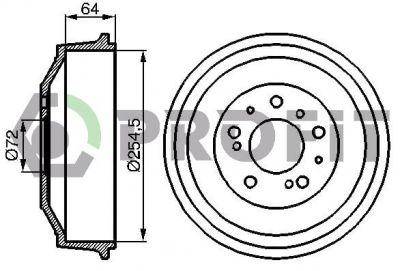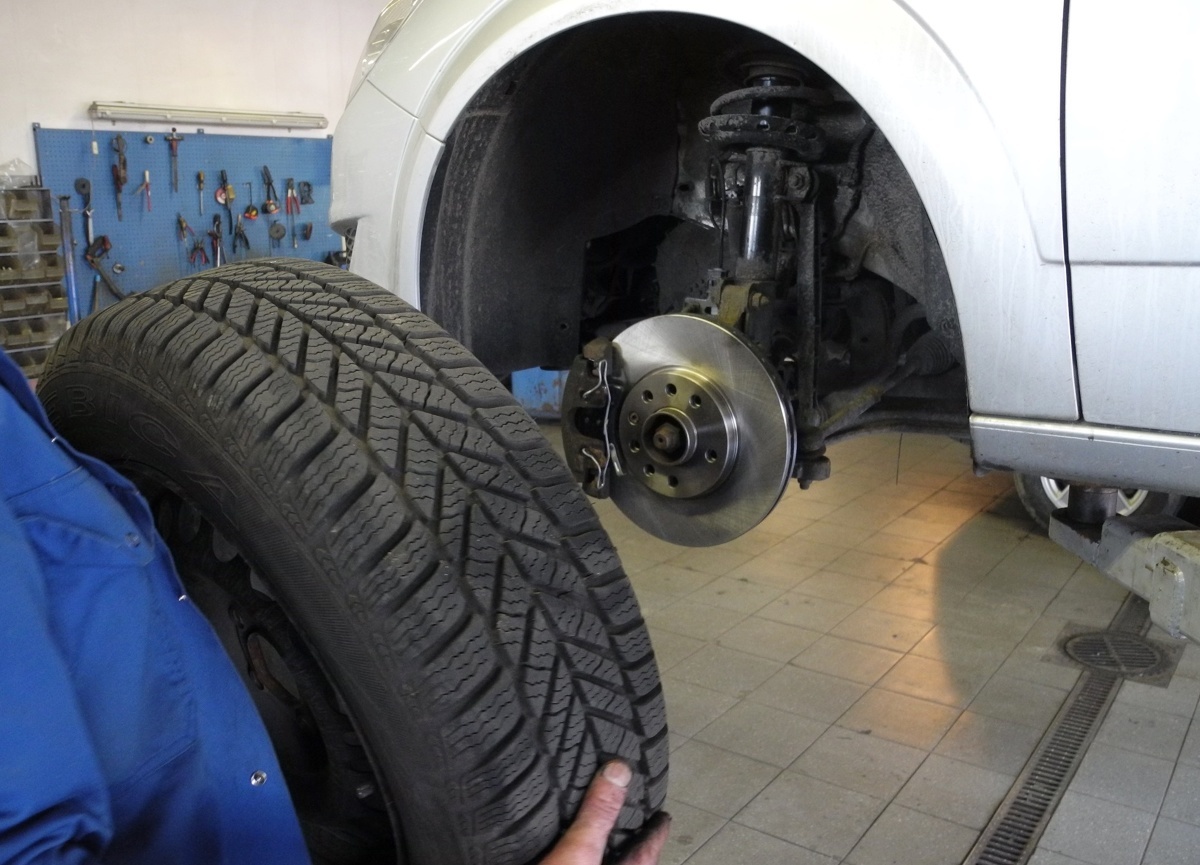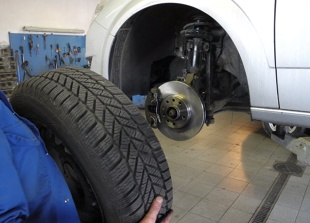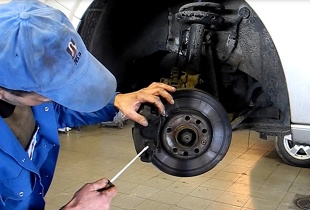
braking system. How to take care of it?
 The braking system is undoubtedly one of the most important elements of the car, directly affecting the quality and safety of driving.
The braking system is undoubtedly one of the most important elements of the car, directly affecting the quality and safety of driving.
In today's article, we will try to present typical problems, malfunctions and basic principles for the correct operation of the brake system. In particular, we will talk about brake pads and discs.
First, a little theory - braking force is needed to brake a car. For its formation, it is necessary to create a braking torque on the wheel. Braking torque is a component of the applied force and the lever on which it acts. The hydraulic braking system is responsible for the application of force, transferring it to the discs through the brake pads. The disc is a lever, so the larger the disc diameter, the greater the braking torque generated.
The braking process itself converts the kinetic energy of a moving vehicle into thermal energy generated by the friction of the brake pads on the discs. The amount of thermal energy is significant. In a civilian car, you can easily heat up the pressure-block-disk system to 350 degrees Celsius! It is for this reason that discs are most often made of gray cast iron. This material is characterized by very good thermal conductivity and ease of creating complex castings. The larger the disc diameter, the more heat it can absorb and the more efficient the braking process can be. However, an increase in the diameter of the disk causes an increase in its mass, and this is the so-called "Unsprung mass", that is, what is not covered by the suspension. The comfort of movement and the durability of the spring-damping elements themselves directly depend on this.
See also: brake fluid. Alarming test results
 Therefore, manufacturers are trying to find a compromise between the force with which the piston presses on the brake pad, and the size of the brake pad and disc. In addition, manufacturers are trying in various ways to get rid of the heat that accumulates on the dial. The friction surface is drilled (through) or ribbed between the working surfaces of the disks (the so-called ventilated disks). All in the name of more efficient heat dissipation.
Therefore, manufacturers are trying to find a compromise between the force with which the piston presses on the brake pad, and the size of the brake pad and disc. In addition, manufacturers are trying in various ways to get rid of the heat that accumulates on the dial. The friction surface is drilled (through) or ribbed between the working surfaces of the disks (the so-called ventilated disks). All in the name of more efficient heat dissipation.
In the case of discs designed for sports or very intensive use, manufacturers often drill or cut the work surface to a predetermined depth to facilitate the removal of gases generated by the friction of the system components. The notches also clean up dirt that accumulates on the pads and trim the tangential surface of the pads so that the pad is always clean and adheres well to the disc. The disadvantage of this solution is the faster wear of the brake pads.
As far as brake pads are concerned, we distinguish four main types depending on the material from which their friction part is made:
semi-metal - the cheapest, quite loud. They transfer heat well, which improves braking efficiency. The cladding is made of steel wool, wire, copper, graphite, etc.
asbestos (LLW) - glass, rubber, carbon bound by resin. They are quiet but less durable than their semi-metal counterparts. Discs are very dusty.
low-metal (LLW) - lining of organic compounds with a small admixture of metals (copper or steel). They are very efficient but loud.
ceramic - they are much more expensive compared to the above types of blocks. They are made from ceramic fibers, fillers and binders. In some cases, they may also contain small amounts of metals. They are quieter and cleaner and have the added benefit of not damaging the brake discs.
 What problems can we face when operating the braking system?
What problems can we face when operating the braking system?
Let's start with the aforementioned thermal energy. If we warm up the discs to the aforementioned 300-350 degrees Celsius (a few dynamic braking from 60 km / h to a complete stop is enough), and then drive into a deep puddle, with a high degree of probability we will observe a pulsation on the brake pedal. with each subsequent braking. Pouring discs with water causes them to rapidly cool unevenly, which leads to their bending. A breaking disc presses on the brake pad, causing unpleasant sensations on the brake pedal and vibration of the steering wheel. There may also be a "kick" of the car when braking.
So avoid driving through deep puddles - our brake discs and other components are sure to pay for themselves in longer use.
We can try to save a warped brake disc by rolling it. The cost of such a service is about PLN 150 per axle. Such a procedure makes sense in the case of curvature of relatively new disks. After rolling, the disc must have the minimum working thickness specified by the manufacturer. Otherwise, you need to purchase a set of new saw blades per axle.
See also: Testing the Mazda 6
Why is it necessary to strictly adhere to the specified minimum working thickness?
Too thin, worn disc no longer has sufficient heat capacity. The system overheats quickly and in the event of emergency braking, you may suddenly lose braking power.
Too thin a disc is also prone to cracking.
A radial disc fracture will result in a murmur that will increase in frequency as rotational speed increases. In addition, during steady braking, pulsation of the brake pedal may occur.
A worn disc can also cause a circumferential fracture. This type of crack is especially dangerous. As a result, the working surface of the disc may fall off the wheel hub!
Another problem that can affect brake discs is surface corrosion. This is not unusual, especially when the air is very humid or we drive on roads sprinkled with road salt. The rusty coating comes off after the very first braking, but we must bear in mind that until the rust comes off, our braking system is noticeably less effective. Corrosion on the discs can be recognized by the characteristic sound the vehicle makes when braking for the first time after a long stop. A characteristic, rather loud friction noise indicates that the pads are scraping rust off the discs.
 Another problem with the brake system is an unpleasant squeak. This usually indicates excessive wear of the friction elements of the system. The metal parts of the brake pad begin to rub against the disc, resonating, causing a loud, obnoxious squealing or scratching sound. In this case, there is no other choice but to replace the worn elements. Replacement should be carried out as soon as possible, since the friction of the metal elements on the disc mentioned above can lead to irreversible damage to the disc. In the case of a quick reaction, the repair may end with the replacement of the pads themselves. Brake squealing can also be caused by dirty surfaces on the discs and pads themselves. In this case, cleaning the system with the so-called Brake Cleaner should help, which will degrease and clean the discs and brake pads.
Another problem with the brake system is an unpleasant squeak. This usually indicates excessive wear of the friction elements of the system. The metal parts of the brake pad begin to rub against the disc, resonating, causing a loud, obnoxious squealing or scratching sound. In this case, there is no other choice but to replace the worn elements. Replacement should be carried out as soon as possible, since the friction of the metal elements on the disc mentioned above can lead to irreversible damage to the disc. In the case of a quick reaction, the repair may end with the replacement of the pads themselves. Brake squealing can also be caused by dirty surfaces on the discs and pads themselves. In this case, cleaning the system with the so-called Brake Cleaner should help, which will degrease and clean the discs and brake pads.
What problems can brake pads have?
First of all, pads can overheat. The thinner, the more worn the gasket, the lower its resistance to high temperature. In the event of overheating, the substance that binds the friction material burns off the pad. The pad has less friction when in contact with the disc, which reduces braking force and durability. In addition, it can cause annoying squeals.
Finally, we should mention the most common mistakes made by drivers, which significantly reduce the durability of the braking system. The most common cause is poor driving technique. Prolonged braking on steep, long descents and constantly keeping your foot on the brake pedal lead to inevitable overheating of the system. When driving in mountainous terrain, remember to apply engine braking and, if possible, use the technique of shorter, harder braking and a temporary release of the brake pedal to allow the system to cool.
As always, it is worth mentioning prevention. At every possible inspection, we require a mechanic to inspect the brake system! This simple, regularly used service action will have a positive impact on our safety, driving comfort and the state of our wallet.